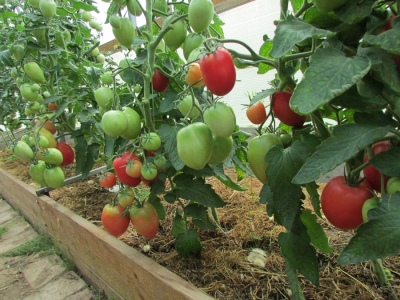
- Authors: Korchagin V.V., Maksimov S.V., Tereshonkova T.A., Klimenko N.N. (LLC "Center Ogorodnik", LLC "Agrofirma Poisk")
- Year of approval: 2017
- Category: grade
- Growth type: determinant
- Appointment: universal
- Ripening period: mid-season
- Ripening time, days: 110-115
- Growing conditions: for open ground, for film greenhouses
- Bush height, cm: 50-60
- Bush characteristic: powerful
Carnelian is one of the most beautiful and attractive minerals. The tomato named after him is at least not far behind. But even with such a good culture, it is very important to dispose of it properly and make a decent effort.
Breeding history
Gardeners owe this plant to the well-known Poisk agrofirm. The breeders Korchagin, Maksimov, Tereshonkova and Klimenko worked as part of the project. Carnelian has been listed in the Federal Register of Approved Plants since 2017.
Description of the variety
This variety is considered universal in its application. Its bushes develop according to a determinant scenario and can develop a height of only 0.5-0.6 m. Therefore, there should be no problems with taking care of them. Despite this, the bushes are highly developed. Moderately oblong foliage of simple green color is typical for them.
The main qualities of the fruit
When the berries have just formed from the ovaries, they are usually light green in color. Tomatoes will turn pink as they develop further. They are large and weigh on average 120-125 g. The characteristic feature of this variety is an inverted egg-like shape with a medium level of ribbing. Each cluster develops 5 or 6 berries.
They will grow on the basis of intermediate inflorescences. The first such inflorescence develops over 6-7 leaves. The next ones usually appear after 1 or 2 leaves. But in some cases, the inflorescences will develop one after the other in any suitable place. Of course, farmers can easily adjust this process.
Taste characteristics
Carnelian pulp has a moderately high density. She is always gentle. Connoisseurs of tastes note its meatiness. Doubts about sugar content are also hardly worth adhering to. At the very least, such a plant is not much worse than the competing varieties.
Ripening and fruiting
Such a tomato belongs to the mid-season group. Between the appearance of the earliest green shoots and the achievement of a mature harvest, usually from 110 to 115 days pass. It is possible to remove the fruits in July, August and September. It is predictable that weather conditions and care measures will affect this result quite dramatically.
Yield
The Carnelian variety is high-yielding. The spread of productivity is 6.7-6.9 kg of berries per 1 sq. m. Obviously, regardless of the growing conditions, it will not be possible to significantly increase the yield. But it is all the more important to take care of the plants carefully so that fertility does not turn out to be excessively low.
The timing of planting seedlings and planting in the ground
You can prepare containers and sow seeds in them in January and February. Even in March it is not too late to do this. You just need to be guided by the climatic norm and horticultural intuition. It is also necessary to remember, however, about the danger of frost return.

Growing tomato seedlings is an extremely important process, because it largely depends on whether the gardener can harvest at all. All aspects must be taken into account, from seedbed preparation to planting in the ground.
Landing scheme
A gap of 30 to 40 cm must be maintained between the individual holes.The permissible density of the placement of bushes is from 3 to 5 pieces per 1 sq. m. Of course, every gardener has the right to regulate this indicator as he sees fit for himself. But excessive thickening of plantings is still unacceptable.

Growing and caring
Cultivation of Carnelian is allowed both in ordinary garden soil and in greenhouses under plastic wrap. Due to the low height of the bush, there is simply no need for a garter to the supports. But the formation of plants will be an absolute must. Otherwise, there are no specific recommendations for the cultivation of this particular variety. Such a tomato feels good both in the sun and in partial shade.
Its decorative properties are large enough to be able to speak about the curb character of the plant. It is necessary to germinate seeds, as is the case with other mid-ripening tomatoes, at a temperature of about +11 degrees. Gradually, this figure should be brought to 20-25 degrees. It is these conditions that are best suited for the cultivation of good healthy seedlings. Planting time for seedlings may vary depending on the choice of soil or greenhouse location.
When the seedlings are placed in their final location, the soil is immediately loosened up. It is necessary to keep it in this state until the end of the growing season. Every watering, every rainfall means the need to tackle the loosening again. Hilling is carried out 9-11 days after transplanting into the ground. The second time, this procedure is carried out, counting another 16-20 days.
During the growing season, the tomato will have to be fed and weeded as needed. And also timely watering is relevant. Normally, it goes through:
when the first and second flower brushes bloom;
before loosening the earth;
after adding dry minerals.
And also Carnelian has to be watered more often when the heat comes. For each bush, they spend 0.7-0.9 liters. Mostly this is done in the afternoon in cloudy weather. Organic fertilizing is applied after the appearance of the first ovaries. This relatively simple approach allows you to achieve a good result.




A plant needs different micronutrients at each stage of growth. All fertilizers can be divided into two groups: mineral and organic. Folk remedies are often used: iodine, yeast, bird droppings, eggshells.
It is important to observe the rate and period of feeding. This also applies to folk remedies and organic fertilizers.



























































































